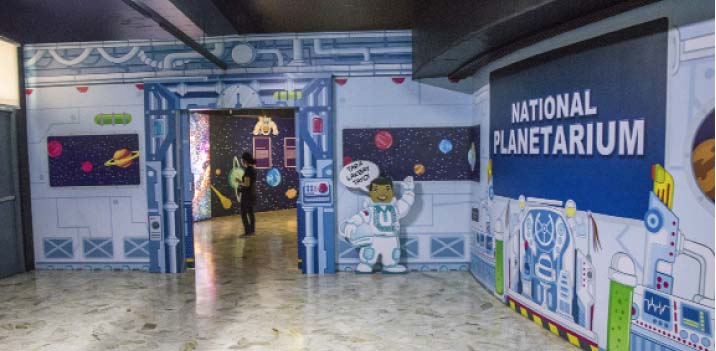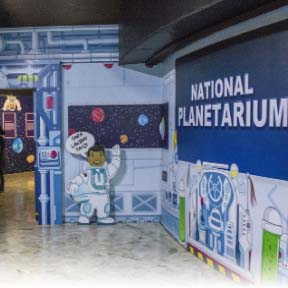
For the past five decades, the National Planetarium has been the main gateway for many Filipinos to learn about the beauty and mystery of the cosmos. It was the brainchild of the former head of the Philippine Astronomical Society, Maximo Sacre Jr., who shared his dream for the planetarium in the early 1970s with Godofredo Alcasid Sr., head of the National Museum at that time. Alcasid was able to sell the idea to the government, which gave them the green light to start the project.
To construct the planetarium, the government turned to the Japanese government for funding and technical know-how. The $100,000 needed for the construction came as part of their war repatriation payment. Work on the planetarium began in 1974 and it was formally inaugurated on Oct. 8, 1975 with its first curator, Sacre Jr. himself.
The centerpiece of the planetarium is its 310-seat dome theater. Since a special projector was needed to project the images to the dome roof, the planetarium brought a GM-15-S Starball projector manufactured by the Japanese company Goto, Inc.
Aside from the theater, the planetarium had an exhibition area that visitors can go see in between screening time. It was divided into two sections –one section showcased paintings of various creation stories from various parts of the country and the other featured dioramas of the solar system and scale models of various satellites and space rockets.

Throughout the 1970s and 1980s, the planetarium became a popular destination for educational trips and tourists. In the early 1980s, it even served as the location for one of multi-awarded actress Vilma Santos’ film, “Relasyon,” where she was a planetarium guide who has an affair with a married man played by multi-awarded actor Christopher de Leon. The film garnered Santos three trophies for best actress.
But after five decades of operation, the planetarium was in desperate need of renovation. Worn down by constant wear and tear, it was in such a bad state that they could no longer offer scheduled screening of shows. One comment in a 2015 TripAdvisor noted that walk-in visitors had to wait to be included into a bigger group if they wanted to view the show at the dome theater.
The National Museum, which oversees the operation of the National Planetarium, was aware of the need for renovation. According to the National Museum’s website, they had already approved the funds for the planetarium’s renovation in 2010. But it wasn’t until after 2015 that work actually began – as the repair of the projector was given first priority. They got in touch with Goto, Inc. The company was astonished to learn that one of their older projectors was still being used.
So, Goto, Inc. gave the planetarium two options: one was to buy a brand new digital projector for P80 million or, they will update the old projector by adding new parts for P30 million. Understandably, the planetarium went for the second option.
With the decision to upgrade the projector made, the planetarium temporarily closed in 2016. Among those who worked on upgrading the projector was the planetarium’s own technician, Roberto Silvestre, who had worked there since it opened in 1975, and was very familiar with the projector as he had spent many hours working on it.
He sometimes went as far as improvising spare parts to keep it running. He worked with the Japanese technicians in taking apart the machine completely and restoring it.
In an interview with Japanese broadcaster NHK, Silvestre admitted that “(I am) quite proud of this. I didn’t expect that it would last this long. But it did. I am glad it will serve us many more years.”
The decision to upgrade the projector turned out to be a good decision. The new added parts enabled it to project digital images to the dome screen. In fact, the planetarium boasts that the quality of their images is even better than those from a digital projector. According to the planetarium, the hybrid projector is still the only one of its kind in the world.
In March 2017, the new projector was finally unveiled to the public. The planetarium could now again offer regular screenings in its dome screen theater.

Along with its new projector, the planetarium got three new half hour documentary features: “A Planet for Goldilocks,” which is about the search for a planet with just the right condition that could support life; “Hayabusa back to the Earth,” which focuses on the journey of a Japanese space probe on the secrets of the solar system; and “Journey to a Billion Stars,” which depicts how scientists – past and present – have been mapping the stars.
Currently, the planetarium rotates the three films in four scheduled screenings from Tuesdays to Saturdays. There are only three scheduled screenings on Sundays. While entry to the planetarium is free, the viewing of films is not. Tickets cost P50, with discounts available for PWDs (persons with disabilities), senior citizens and students.
Aside from the dome screen theater’s renovation, the planetarium also introduced its new mascot, Juanito Filipino, Astronaut. You can meet Juanito and his Barong Tagalog-inspired spacesuit at the exhibition area.
Instead of the rather scattered approach in the old exhibit area, the planetarium decided to focus on the theme of how ancient Filipinos viewed the cosmos and how their observation benefited us until today.
I was amazed to learn that ancient Filipinos were able to observe and monitor the sun, moon and stars and come up with their own view of the cosmos, which they used to tell time as well as navigate the seas. In fact, there are still people today who use the same method of time telling and navigating as their ancestors did.
While the National Planetarium cannot compare with planetariums in other countries, it still continues to inspire generations of Filipinos to keep looking and studying the skies above us.
Hopefully with the new renovations and upgrades, it will continue inspiring more Filipinos to be interested in astronomy for generations to come.
